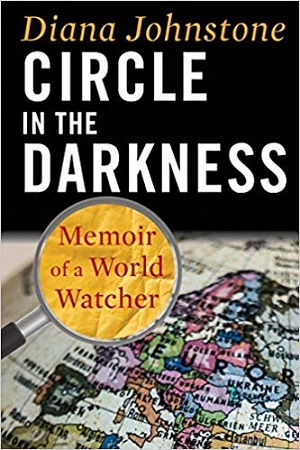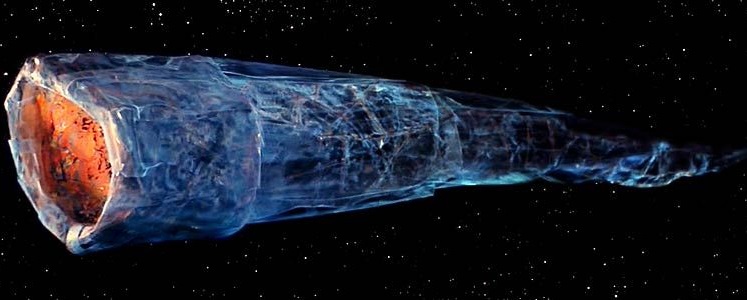Circle in the Darkness: Memoir of a World Watcher (2020)
A Book Review

First, Diana Johnstone’s memoir is a classic, and will be read and quoted as long as we keep struggling for peace and justice. It is one of the great personal accounts of the anguished decline of our uncivilization, both a riveting eye-witness account of many of the horrors and perfidies, and a primer for students of history and all those struggling to not only dismantle the beast, but to prepare us for what follows it.
Read it and weep. And smile at the follies. And shout ‘Yes!’ as light bulbs flash in your mind.
Johnstone’s concern in Circle in the Darkness is not so much ‘the lived experience of the transitory nature’ of things but ‘especially of the moral environment.’
She was blessed to to begin at the beginning of the end. At the empire’s undisputed zenith under FDR. And though not a card-carrying anything religious or left wing, she grabbed that blessing and stoked and nurtured it, creating her life, her jobs, a single mother raising a daughter in Minnesota and then France, seeing through the cant everywhere and using her only weapon, the pen, to expose it.
It is a frightening, unremittingly gruesome, Dantesque journey, but Johnstone’s steady moral compass sees us through and is uplifting.
 One of her first memories is seeing the Minerva of Peace mosaic by Elihu Vedder (1896) in the Library of Congress Thomas Jefferson Building, Washington, DC, with its very unpeaceful message: Minerva’s peace and prosperity is attained only through warfare.
One of her first memories is seeing the Minerva of Peace mosaic by Elihu Vedder (1896) in the Library of Congress Thomas Jefferson Building, Washington, DC, with its very unpeaceful message: Minerva’s peace and prosperity is attained only through warfare.
Diana Johnstone (right)
Nike, a representation of Victory, similar to those erected by ancient Greeks to commemorate their success in battle, stands next to Minerva. I doubt that 3-yr-old Diana would have been able to articulate this message, but it hit me: this was a sign from beyond, be it from God or whatever. This little lady was fated to wrestle with the forces of war and peace till the day she dies.
So I thought: And what was happening in America in the 1890s to inspire Vedder (and Diana)?
1890: Wounded Knee Massacre in South Dakota, Wyoming, Idaho join the Union.
1893: severe economic depression, as well as several strikes in the industrial workforce.
The decade saw much of the development of the automobile.This decade was also part of the Gilded Age, a phrase coined by Mark Twain, when the super rich were even more super, and the rest were super poor.
The Philippine Revolution began in 1896, ceded to US in 1898. The Provisional Government of Hawaii sent armed militia against the lepers in the Leprosy Colony of Kalawao. The template for Minerva’s ‘peace through war’.
Hey, isn’t that today’s empire? Just more of the same?
History comes to life in Johnstone’s reflections, which cover almost a century, from the depths of the Depression and the rise of FDR to the sputtering loose canon of Trump, with America looking in many ways like the mess it was when Johnstone was born.
But it is not mass unemployment that is the chief cause of the malaise today. Keynes and a massive state sector combine with Eisenhower’s ‘military industrial complex’ more or less ‘solved’ that. The problem is deeper. It is the same uneducated nation, steeped in ‘enemies’, for the past century, anti-communism, writ large despite the demise of communism. The fear of yet another world war, environmental armaggedon, capitalism blind to its fatal flaws. And Americans too, blind and ignorant of foreign affairs, always fearful of the ‘other’, willing to leave world affairs in the hands of officials, who presumably know better.
Johnstone has spent most of her life abroad, in France, the rare foreign correspondent (she created a job as foreign correspondent for In These Times) who has free rein to explore a story, and a mission from the left wing ITT, to cover socialist/ communist politics in Europe, bringing her to meet with and cover the careers of remarkable people such as Olaf Palme and Willy Brandt, and to reflect on the demise of the old guard communists such as Marchais and Berlinguer and the embrace of social democracy by the heirs of Lenin and Stalin, so-called Eurocommunism, which abandons any thought of revolution, relegating it to oblivion.
Circle in the Darkness is almost an encyclopedia of the landmark events, which Johnstone covered as both journalist, participant, friend and enemy. Her calm passion for justice motivates her throughout her very ‘lived life’, someone for Socrates to admire, like Johnstone, crucified for his unflinching honesty. Though she may not have stopped the Vietnam war (‘the Viet Cong did that’), she created ways to help, inventing first a Community Contact outreach program to knock on doors to talk about Vietnam with the Minnesotan public.
Then she invented ‘people’s diplomacy’, organizing a group of 30 widely diverse Americans to go with her to her already beloved Paris in 1970 to meet with the South Vietnamese provisional government and the North Vietnamese, hoping to take the message of peace back to the US.
Johnstone loves her subject, whatever it may be, and her description of some of the colourful participants (and some tragic fates) is delightful and arresting.
The vegetable farmer George Panayotoff was especially active in speaking to every meeting he could find, often together with Robert Nienkerk, a private detective. Nienkerk was truly amazing. He could speak to the most conservative groups, such as the Veterans of Foreign Wars, and with his Mr. America necktie, short haircut and straightforward manner, win them over.[1]
But, like most genuine efforts in the quest for peace, they were met by a deafening silence from the mainstream media (International Herald Tribune: It’s only a local story. Go to your home town for a human interest piece.) The Cold War Deep State had taken the US empire’s foreign affairs off the table, made it ‘bipartisan’, which with the rise of the powerful Israeli lobby, made the empire a US-Israeli empire, even more a captive of Eisenhower’s nemesis, the military industrial complex.
Speaking of arresting, her own arrest in Paris at a Vietnam rally during the chaotic summer of ‘68 was the essence of civilization. She explained to the French policeman when they reached the police station that she had to pick up her daughter from school, and he let her go. She realized he was against the Vietnam war, as were virtually all the French, and admired her courage.
There is much of interest both to historians and activists. Johnstone is a master of cutting to the quick, Occam’s razor. Most world events are so complex, assassinations in particular, that they remain a matter of conjecture. But she was on the spot for such events as the attempted assassination of Pope John Paul II in 1981, and the ‘successful’ one of Olaf Palme, and followed the ‘investigations’.
Agca, a truly crazy Turk, was already in the sites of authorities, a ‘grey wolf’ fascist, who reveled in his act, claiming first
he was ordered to kill the Pope by the Turkish mafia, then by the Popular Front for the Liberation of Palestine, even by Cardinal Agostino Casaroli, the Secretary of State of the Vatican. Nobody took any of that seriously. But almost a year and a half later, in his Italian cell, he came up with a new story, which unlike all the others was widely welcomed as a “confession” of the truth: he had shot the Pope on instructions from Bulgarian agents, acting on orders from the Kremlin … later proclaiming himself to be Jesus Christ. But he had every reason to go along with the Bulgarian Connection story. He could be assured that it would guarantee comfortable prison conditions. It made him a media star. And shifting the blame to the communist Warsaw Pact enemy.
Perfect for the US and its ‘NATO allies who had internalized the need for US protection, whether from Russia or from their own domestic left.’
Useful to Agca, keeping him amused and famous. It was useful to the Italian right in its relentless effort to destroy the Italian Communist Party. It was useful to the American war party, … useful to the Vatican, not only as anti-communist propaganda, but also as the occasion to enact a characteristically Christian morality play, in which the Pope pardons a repentant Agca in his cell. Nor could leaders of Turkey, a NATO ally, mind having blame shifted to Bulgarians. The one who had no reward was the hapless Bulgarian travel agent, Sergei Antonov, who spent over three years in prison before being acquitted, a broken man. it illustrated how easy it was to build a major international political scandal out of a “confession” methodically extracted by intelligence agents from a convicted pathological killer and sold to the public by mass media. It is all too easy to tell the American public wild tales about “the rest of the world,” about which their school system has taught them little.[1]
I’m ashamed to say, if you had asked me before Circle about JPII’s almost assassination, I would have said, ‘Supposedly a Bulgarian assassin.’ Our brains work ‘Last in, first out.’ It is sooo hard to stay ahead of the game.
This legacy of the Nazis was also behind the assassination of Palme. The pompous New York Times investigation took months (and lots of moola), and turned up nothing. But plucky Diana, on a shoestring, went to Lund University to learn of the independent investigation by historian Wilhelm Agrell, who dismissed attempts to pin it on Kurds or South Africa. ‘He settled on the ‘patriotic’ motive: the explanation that Palme was eliminated by elements within Swedish security or armed forces that considered him a threat to the nation.’
In the 1930s, Swedish fascists in the military supported Hitler, Sweden remained neutral, useful to Germany in its occupation of anti-fascist Norway, and that legacy remained. The Germans were replaced by the Americans after the war, with the common enemy, the Soviet Union, still in place.
Palme was hated by the right, especially the military, who were becoming irrelevant to Palme’s vision of Sweden as a haven of peace, a friend to (peace loving) Soviet Union. His assassination, done from within, could be kept under raps, unsolved, but attributable to nasty apartheid South Africa, which certainly loathed Palme too. Agrell, a prominent expert on Swedish military doctrine and (from 1990) a member of the Royal Swedish Academy of War Sciences, and his claim disappeared from view, mentioned, it seems, only by Diana at ITT. Agrell’s wikipedia page makes no mention of what surely is his ‘finest moment’. How the mighty have fallen.
I could go on with many more beautifully written, barbed Occam’s razors, but I will end on some morsels of inspiration of my own, courtesy of Johnstone. Diana disclaims labels, but her analysis is Marxist in the best sense of the word, not the eurocommunist, ‘cultural Marxist’ which neoliberalism produced as a distraction from the remorseless destruction of all that’s good, which capitalism thrives on.
This is the subtext of Star Wars ‘Doomsday Machine’ (1967), where Kirk destroys the alien robot planet-eater, left behind by warring civilizations but still roaming the universe in search of planets to destroy and eat, long after its ‘masters’ have killed each other and the machine has eaten up their planet. To kill the beast, Kirk feeds it a tasty H-bomb, a version of Earth’s very own quaint 20th century doomsday bomb, ‘the first time it has been used constructively.’ The Doomsday Machine, of course, is capitalism/ imperialism, and its avatar today US-Israel, seizing whole nations, eating up the Earth’s treasures, a doomsday machine to kill us all.

My other ‘morsel’ recalls The Fatal Embrace: Jews and the State (1993), where author Benjamin Ginsberg, concerned with an Israel already out of control in 1990, argued that for their own purposes, rulers often were happy to accommodate Jews in exchange for their services, resulting in “the rise to great power by Jewish elites, but creating conditions for their subsequent fall.” They made alliances “responsible for the construction of some of the most powerful states of the Mediterranean and European worlds, including the Hapsburg, Hohenzollern, and Ottoman empires.” This led to the paradoxical situation where some Jews were ministers or viziers while the majority of them were oppressed and rebels, a foretaste of the twentieth century Great Games.[2]
Johnstone witnessed three examples of these latter day ‘viziers’ during the 1980s:
- adviser to Sartre (Benny Lévy, a Maoist in ‘68),
- adviser to Mitterand (Attali),
- destroyer from within of the Green Party of France (Cohn-Bendit).
Sartre’s friends were appalled when an attractive young Svengali (Levy) mesmerized him as he lay dying, inducting him into Kabbalah mysteries. Levy himself had shifted from Maoism to Judaism, or ‘from Mao to Moses’, i.e., fill the spiritual gap of dying atheist Sartre with harmless Jewish mysticism, ignoring the Zionist monster at work in the real world.
Unelected Attali wormed his way into President Mitterand’s private circle and convinced him to abandon his socialism and quest for detente, for neoliberalism and more anticommunism.
In December 2014 the daily Libération opened its article on Attali with the rhetorical question, “And what if it turns out that Jacques Attali, 71, is the real President of France?” This thought was inspired by the fact that at that very time, Attali was guiding his protégé, Emmanuel Macron, through his first big political job as Minister of Economy in the Socialist Government of François Hollande, designing laws to reduce worker rights.[3]

Gadfly Cohn-Bendit (with his fellow traitor Fischer of the German Greens) gutted the Greens of their quest for peace and disarmament, so dear to Johnstone’s (and my) heart, in favour of R2P, their crowning achievement, the 1990s the destruction of Yugoslavia.
Johnstone’s crowning achievement is undoubtedly Fools’ Crusade: Yugoslavia, Nato, and Western Delusions (2003), which sifts through the bombed-out rubble of poor Yugoslavia, revealing the real story, the real culprits. In the fine tradition of western media, she faced screaming silence, unable to get the message into the mainstream. I wondered at her passionate devotion to this particular cause, but after reading Circle, I understand. At the tender age of 19, she was able to join a pre-Peace Corps (SPAN, the Student Project for Amity among Nations) visit to Belgrade, just months after the death of Stalin in 1953. Serbia circa 1953 was simple but civilized, full of spirit, building a new society.
My own such experience, studying Russian in Moscow in 1979, had the same impact on me, and accounts for my own struggle to save at least the ‘memory of memories’ of that lived reality so different, faulty but in many ways, far superior, to what US-Israel has left behind after our Doomsday Machine ate up that tasty morsel.
*
Note to readers: please click the share buttons above or below. Forward this article to your email lists. Crosspost on your blog site, internet forums. etc.
This article was originally published on the Centre for Research on Globalization (CRG)
Notes
[1] Johnstone Circle in the Darkness: Memoir of a World Watcher, Clarity Press, 2020, 94, 191.
[2] Eric Walberg, Canada Israel Nexus, Clarity Press, 2017, 66.
[3] Johnstone, op.cit., 160.

